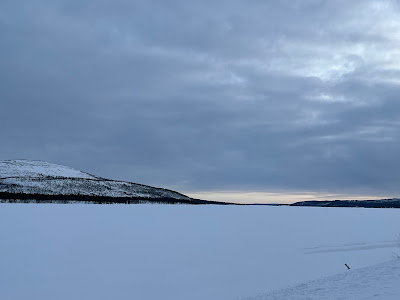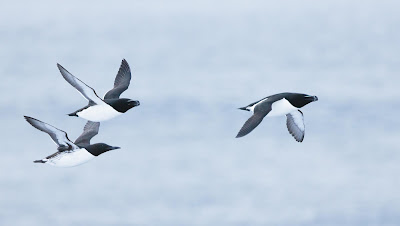Back in early 2022, as travel was beginning to regain steam after the height of the pandemic, I was looking for a solo northern adventure that would offer an opportunity to view the aurora borealis, a natural phenomenon that I had been wanting to observe for some time. Early Spring was an appealing time because, as much as I wanted to experience the lights, I had little interest in spending an entire vacation in darkness. The aurora "shoulder seasons" of autumn and spring hold significant daylight at the high latitudes, enough to combine typical daytime outdoor activities with nighttime aurora vigils. This means little sleep, but the adrenaline is enough to keep you going.
The decision of where to go then had to be made. Obviously the destination should lie somewhere in the "Aurora Belt," that area between 60 and 70 degrees latitude where auroras are most often visible. Alaska first came to mind, specifically Fairbanks, but the wildlife throughout interior Alaska in March is not terribly active or speciose. Thoughts of someplace more far-flung came to mind, and a bit of research revealed two doable options: Iceland and northern Scandinavia. Iceland is conveniently reached via a direct flight from my region, but the allure of Scandinavia was too strong to ignore.
Researching the trip, it seemed photography should be a priority. Obtaining images of the northern lights would add another dimension to the experience of viewing them, and I was excited by the idea of attempting astrophotography for the first time. Up in Varanger, Norway, a floating blind was available for duck photography, and a visit to a seabird colony might produce close views of alcids. I had been contemplating an upgrade to mirrorless camera technology anyway, and this was the kick in the pants I needed to make the switch. So I sold a kidney and picked up a new kit: Canon R5 and the 100-500mm RF lens.
The centerpiece of the vaca would be Varanger, which I bookended with a couple days each in Tromso and Olso. Since this is a birding-focused space, I'll focus on my time in Varanger, 24-28 March 2022.
My flight landed in Kirkenes on the morning of the 24th. Car collection from Hertz was quick and easy, and soon I was in a hybrid Toyota sedan with studded snow tires, which proved to be a surprisingly competent vehicle despite the packed snow-covered roads. The first destination was the Pasvik Valley, named for the Pasvik River that separates this part of Norway from Russia. I had only scheduled about 24 hours to bird the taiga forest there, in hopes of finding SIBERIAN JAY and SIBERIAN TIT. I did connect with both of those species plus displaying BLACK GROUSE, NORTHERN HAWK-OWL, EURASIAN THREE-TOED WOODPECKER, LESSER SPOTTED WOODPECKER, PINE GROSBEAK and HOARY REDPOLL. During winter it is basically all roadside birding here, and every waterway is frozen and masked by snow, including the large river. As you'd imagine, diversity is low. Activity is concentrated around the small villages and bird feeders that are scattered through the valley.
 |
| Siberian Jays |
 |
| Siberian Tit |
 |
| Northern Hawk-Owl |
 |
| Pine Grosbeaks |
 |
| Hoary Redpoll (rear) and Common Redpoll |
 |
| Looking across the frozen river to Russia |
 |
| The harsh landscape that awaits, flying into Kirkenes |
 |
| My location in the Norwegian portion of the valley. That's Russia to the east and Finland to the west. |
My one night in the valley was spent at Ovre Pasvik Camping, which exceeded my admittedly low expectations. I had a double bunk room to myself complete with super effective space heater and an electric cooktop with utensils. I was plenty warm and comfy. That night I spent some time using playback for Boreal Owl, but it was very windy and there was no sign of owls. I did catch a very brief but exhilarating first look at the aurora borealis!
Following this quick but successful dip into the valley, I backtracked north on my way to the Varanger peninsula. I arrived mid-afternoon on the 25th at the iconic church at Nesseby en route to my Airbnb in Vadso. A EURASIAN COOT in Vadso harbor was a rare find for this far north.


I spent the 26th birding the coast eastward and finding my first STELLER'S and KING EIDERS of the trip. VELVET SCOTER were far less common than I thought they'd be; in fact I saw only one pair in my few days along the coast. Driving eastward towards Vardo was made interesting by several intermittent snow squalls that kept rolling through with a fierce intensity. Spectacular coastal views would transition to whiteout conditions in a matter of seconds, and ten minutes later the sun would be shining again. The vast coastal arctic landscape was nothing short of stunning to observe as dramatic gray clouds alternated with bright sunlight all afternoon. As I write this well after the fact, now having been here in both late winter and summer, I can say that the winter landscape is more beautiful, though admittedly the June midnight sun is something to behold. The afternoon of the 26th was spent on and around Vardo, taking in the white-winged gulls, ROCK PIPITS, PURPLE SANDPIPERS and yet more eider.

 |
| Fieldfares |
 |
| Bird cliff at Ekkeroy, where thousands of Black-legged Kittiwakes breed |
 |
| Steller's Eiders |
 |
| Purple Sandpiper |
 |
| The variation in male Common Eider bills is always interesting to observe anywhere in their range |
 |
| Views from the coastal road to Vardo |
 |
| Views of Hornoya from land |
I hopped on the first boat to the island of Hornoya on the 27th, which is a fast 10-minute boat ride away. Unfortunately several days of strong north winds and snow squalls had prevented the recently-arrived alcids from settling into their nesting habits. As a result, very few birds were on the island itself. Swarms of COMMON MURRES circled the island as they waited for the weather to settle. Among the flocks were smaller numbers of THICK-BILLED MURRE, RAZORBILL and ATLANTIC PUFFIN. At times the snow was so heavy that birding was impossible and I could do nothing but lie down and soak up the beauty while the squall passed.
 |
| Thick-billed Murre (left) with Common Murres |
 |
| Thick-billed Murre |
 |
| Atlantic Puffin |
 |
| Two Razorbills lead a Common Murre |
 |
| Atlantic Puffin |
 |
| European Shag |
 |
| The boat to Hornoya pulls into the dock at Vardo |
 |
| The lighthouse at the top of Hornoya |
 |
| Hornoya snow squall, one of many |
 |
| nap time |
I had a long drive ahead of me that night, my last in northern Norway. After that brief aurora display on my first night in the Pasvik Valley, every night since had been shrouded by clouds. It was looking like I might go home without seeing the Northern Lights in all their glory. Finally that evening, as I drove towards Batsfjord, the skies cleared and I got the show I was looking for. Something I will never forget.
 |
| Conditions were prime for an aurora show |
I never did sleep that night. Between the driving and the aurora-watching, I arrived at Batsfjord just before our scheduled departure to the floating blinds that are strategically positioned in the eider's feeding grounds. I lucked out and had an entire blind to myself, thanks to a group from Finland that was delayed by weather. Duck numbers were not super high, but all three eider species were represented and periodically made close approaches. Anyone visiting the area during winter-spring and interested in photography should absolutely spend a morning in these blinds because you'll likely never get so close to these species anywhere else.
 |
| Steller's Eiders |
 |
| King Eiders |
 |
| Long-tailed Duck |
 |
| View from inside the blind |
 |
| Blind from the outside |
After grabbing some hot food in town I birded the harbor from land and then started the drive back to Kirkenes for my flight to Oslo. Two more NORTHERN HAWK-OWLS en route were a great way to end a whirlwind trip to Finnmark.
 |
| Nothing but snow-covered tundra for miles |
As I write this a year and a half later, this might be my favorite post-COVID trip so far and one of the most enjoyable of all time. The arctic tundra is a truly special place, and seeing it for the first time as a winter wonderland put the experience over the top. If I did it again, I would have scheduled at least two more days to explore the area, though limited time off from work did not afford that luxury this time...
































































Comments
Post a Comment